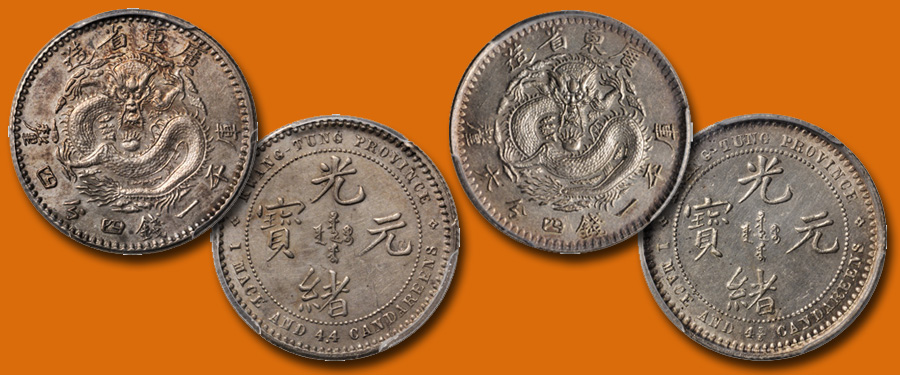
The Stack’s Bowers and Ponterio inaugural December Macau Showcase Auction is just two weeks away! For our preview this week we offer two for one — two separate lots that represent two stages in the development of a highly collectible series of Chinese Provincial coinage. Authorization to establish the Kwangtung mint was granted in 1887, implemented by Viceroy Chang Chi-Tung. In order to modernize the mint, minting machinery, dies, hubs and other equipment were ordered from the Heaton mint at Birmingham. Upon their arrival in 1888, Kwangtung became the first mint in China to use modern minting machinery. At the time, this mint was the largest in the world. Patterns for the first coins were designed by Allan Wyon in the denominations of 10 Cents, 20 Cents, 50 Cents and 1 Dollar. The first Heaton patterns were later delivered to the Chinese ambassador in London. For some reason, the initial order did not include the 5 Cent piece which was struck later at the Kwangtung mint. The series is referred to by numismatists as the "Seven Three Reversed Pattern." The term "Seven Three" directly relates to the silver content. The term "Reversed Pattern" refers to the English and Chinese legends which are reversed from what later became standard. Initially, Kwangtung introduced the first coinage with a higher silver value, with the intention of replacing foreign coins circulating within China. The standard metallic content was slightly raised in an attempt to gain popularity over foreign coins in circulation. However, once this was realized, individuals began melting them down to retrieve the excess silver content.
Upon the realization that the first Kwangtung issues were being melted for their extra silver content, authorities quickly ordered a modification to the coinage design. New patterns were produced at the Kwangtung mint using hubs supplied by the Birmingham mint. Essentially these were identical to Allan Wyon’s original design with the weight of the Dollar changed from 7 Mace 3 Candareens to 7 Mace 2 Candareens and with similar modifications for the corresponding smaller denominations. Another subtle change made on some denominations, was the addition of small rosettes at either side of the dragon. Like the “Seven Three” coinage, this new modified design was destined for failure. The overall design failed to meet with the approval of the Peking authorities due to the placement of the Chinese and English legends. The mint was then instructed to shift the English and Chinese text to the opposite sides of the coins.
We’re excited to offer both stages of this development in our December Macau sale. The first stage is represented by lot 32254 and the second stage by lot 32255. Each is a rarity in its own right, and exemplifies the early developments in Chinese coinage. Both pieces are lightly toned with abundant luster and sharp strike details on the intricate dragon designs that would come to symbolize Chinese numismatics. Each piece is expected to attract spirited bidding when it crosses the auction podium.
Look for this and other Asian and world numismatic rarities in our upcoming December Macau Showcase Auction. Preview this impressive coin along with the rest of our auction this November at the Stack’s Bowers and Ponterio office in Irvine, California. For details please refer to the Events Calendar link at www.StacksBowers.com. To schedule an appointment, please call 800.458.4646. While our Stack’s Bowers Galleries December Macau Showcase Auction is no longer open for consignments, we are currently taking consignments of Asian and world coins for our April 2015 Hong Kong Showcase Auction and our August 2015 ANA World’s Fair of Money Showcase Auction. If you are interested in consigning your coins and paper currency (whether a whole collection or a single rarity) be sure to contact one of our consignment directors.





